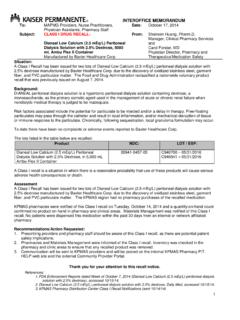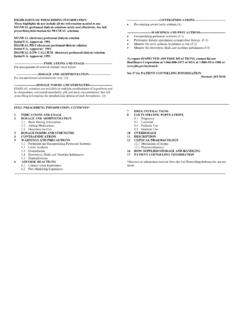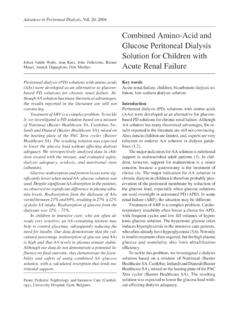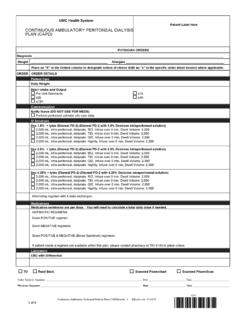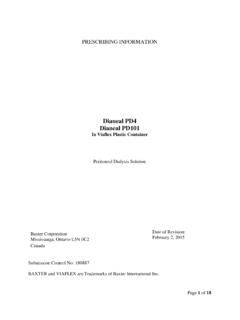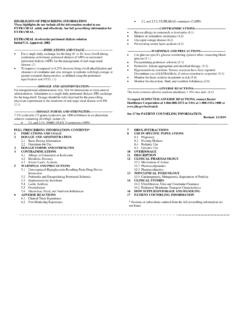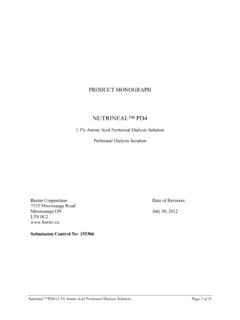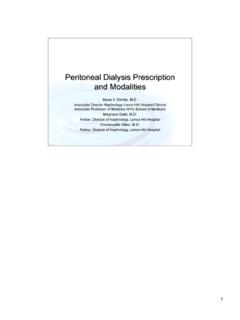Transcription of DIANEAL PERITONEAL DIALYSIS SOLUTION
1 DIANEAL PERITONEALDIALYSIS SOLUTIONC alcium chloride; glucose; magnesium chloride; sodium chloride; sodium lactateConsumer Medicine InformationDIANEAL PERITONEAL DIALYSIS SOLUTIONP ublished by MIMS/myDr December 20061 What is in this leaflet?This leaflet answers some commonquestions about DIANEAL PeritonealDialysis SOLUTION . It does not containall of the available information. Allmedicines have risks and doctor has weighed the risks ofyou using DIANEAL PERITONEAL DialysisSolution against the benefit theyexpect it will have for does not take the place of talking toyour doctor or you have any concerns abouttaking this medicine, ask yourdoctor or DIANEAL PeritonealDialysis SOLUTION is usedfor?Kidney failure occurs when thekidneys can no longer functionadequately and a person's survivaldepends upon either a kidneytransplant or renal replacementtherapy, including is the process of filtering orcleansing the blood of waste productsand excess water and removing themfrom the body.
2 There are twomethods of DIALYSIS treatment -haemodialysis and peritonealdialysis. Both employ speciallyformulated solutions to performblood DIALYSIS uses the body'sown PERITONEAL or abdominalmembrane as a filter to cleanse theblood. The PERITONEAL membranelines the PERITONEAL cavity. A steriletube called a catheter is inserted by asimple surgical procedure throughthe wall of your abdominal provides an opening throughwhich the DIALYSIS SOLUTION can beinfused into the abdominal products pass from the bloodstream, through the peritonealmembrane and into the dialysissolution. Blood cells and largemolecules such as proteins areretained since they are too large topass through the membrane. Theused DIALYSIS SOLUTION is periodicallydrained from the abdominal cavityand replaced with fresh SOLUTION ,usually 3-4 times a DIALYSIS procedures areeasy to learn but it is imperative thatyou adhere to the procedure taughtby your health care are two ways of performingperitoneal DIALYSIS : ContinuousAmbulatory PERITONEAL DIALYSIS (CAPD) or Automated PeritonealDialysis (APD) ( , peritonealdialysis performed by a machine).
3 PD ( PERITONEAL DIALYSIS ) offerscontinuous self-care you use DianealPeritoneal DialysisSolutionThe exchange procedure involvesdraining the used DIALYSIS solutioncontaining the waste products, andinstilling fresh SOLUTION into theperitoneal cavity. This must beperformed with great care to avoidinfection. The exchange procedureshould be undertaken where there isprivacy and a clean, well-litenvironment: home, office orbathroom. The environment shouldbe clean, dust-free, ventilated butfree from is important that the catheterexit site on the abdominal wall iskept clean and free from catheter must be ensure this, you will berequired to examine and cleanseyour exit site daily. This must bedone in the manner in which youwere taught during your peritonealdialysis the product label for thecorrect volume, Glucoseconcentration and expiry integrity of the pack should bechecked by squeezing the bag andexamining carefully for signs ofleakage.
4 Ensure that the solutionis PERITONEAL DIALYSIS SOLUTIONP ublished by MIMS/myDr December 20062 How to use DianealPeritoneal DialysisSolutionThe single most importantconsideration in PD is asepsis, ,maintaining very clean conditionsduring all procedures. While theexchange procedure is a simpletechnique to learn, it must be donewith great care every time. This isbecause there is always a risk thatyou may contaminate the solutionand therefore cause an will probably be necessary to warmCAPD solutions to body temperaturebefore use. Specially designedthermostatically-controlled portablewarming boxes are available for thispurpose. Use of microwave ovens isnot recommended because theproduct may be damaged,resulting in leakage and risk APD the machine warms thesolution to body temperature beforeit is installed in the PERITONEAL important points must beconsidered before and during use ofDianeal PERITONEAL DialysisSolutions:1.
5 Use the solutions strictly inaccordance with theinstructions provided to youduring your PERITONEAL You should dialyse only withthe volume of SOLUTION and atthe frequency prescribed byyour Kidney Doctor or yourDialysis For the route of administration,please see Description and Useof PERITONEAL DIALYSIS Do not use the SOLUTION unless itis clear and the seal is Aseptic technique must be usedall The expected effects of dialysisare correction of acid-basebalance and electrolytedisturbances, fluidaccumulation and removal oftoxic waste products from Failure to perform DIALYSIS asordered by your Kidney Doctorwill result in rapid acid-basebalance disturbances and fluidaccumulation (which may resultin pulmonary oedema andelectrolyte imbalancesincluding raised serumpotassium).
6 This could cause alife-threatening Cessation of DIALYSIS must be inconsultation with your KidneyDoctor or the Renal Unit orDialysis An accurate fluid balancerecord must be You must check your weightregularly to avoid accumulatingfluid in your You will be required to haveregular blood tests in order tomonitor your You should regularly visit yourKidney Doctor or the RenalUnit or DIALYSIS you are usingDianeal PeritonealDialysis SolutionDiscuss with your doctor ordialysis nurse the progress youhave experienced during thetreatment, whether anycomplication has occurred,especially during the first few daysof therapy. Frequent clinicalevaluation and laboratory testsmay be effectsPatients using PERITONEAL dialysishave experienced one or more of thefollowing unwanted effects:abdominal distension, loss ofappetite, constipation, scrotal orlabial swelling, backache, posturaldisturbances, pain on inflow and/oroutflow, peritonitis(inflammation/infection of theperitoneal cavity), exit site infection,tunnel infection, muscle weaknessand cramps.
7 Any undesirable effectshould be reported immediately toyour Kidney Doctor or the RenalUnit or DIALYSIS case of OverdoseIf you accidentally infuse a largervolume of DIANEAL thanprescribed by your Kidney Doctor,you may experience abdominaldistension and pain. If you exceedthe number of exchangesprescribed, muscle weakness andcramps may occur. You shouldseek advice from your KidneyDoctor or the Renal Unit orDialysis DescriptionsWhat DIANEAL PeritonealDialysis SOLUTION looks like? DIANEAL PERITONEAL DIALYSIS Solutionsare supplied in either a single Viaflexplastic bag or a Freeline Solo TwinBag ( SOLUTION bag with drainage bagattached).What is in DianealPeritoneal DialysisSolution? DIANEAL PERITONEAL DIALYSIS Solutioncontains the following ingredients: DIANEAL PERITONEAL DIALYSIS SOLUTIONP ublished by MIMS/myDr December 20063 Active Ingredients:Calcium Chloride, Glucose,Magnesium Chloride, SodiumChloride, Sodium LactateInactive Ingredients:Water for Injections, SodiumHydroxide, Hydrochloric AcidHow to store DianealPeritoneal DialysisSolutionStore DIANEAL solutions underclean, dry conditions, protectedfrom physical damage and attemperatures not exceeding 30 , individual bags may bewarmed in a warming box to 38 Cprior to use.
8 Microwave ovensshould not be used (see above).The duration of warming anindividual bag should not exceedone expiry date is located on thebottom right-hand corner of thelabel. solutions should not be usedafter the expiry date. DIANEAL SOLUTION should be clear. If it isnot, do not use that bag; isolate itfrom your stock and return it toyour DIALYSIS Centre. Do not usesolutions from damaged can you getmore information?Further information can be obtainedfrom your Kidney Doctor, or theRenal Unit or DIALYSIS Centre of thehospital which provided yourperitoneal DIALYSIS and address ofthe SponsorManufactured by:Baxter Healthcare Pty Ltd1 Baxter DriveOld Toongabbie, NSW 2146 AustraliaDistributed in New Zealand by:Baxter Healthcare Ltd33 Vestey DriveMount WellingtonAuckland 6 New ZealandThis Consumer MedicinesInformation Leaflet was revised 6thDecember 2002
